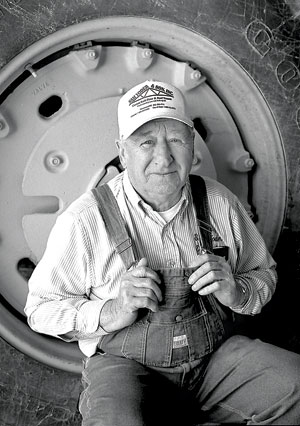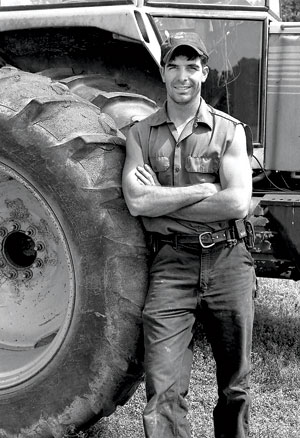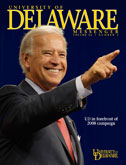Bringing lives into focus
When Kathleen Buckalew, AS ’78, used her camera to explore Delaware’s family farms, most of her photos turned out to be portraits, not landscapes.


“I can research agriculture in Delaware,” she says, “but it’s the face that reveals what’s inside a person who works the land for a living. It was really powerful getting people’s stories on film and hearing from one viewer how moved she was by the spirituality that came through the farmers’ words.”
The photographic project she shot and produced, “The Face of Farming: Delaware’s Family Farms,” includes oral histories and will soon become a book. All the portraits are in black and white.
Buckalew, staff photographer for the Hagley Museum and Library in Wilmington, Del., says she has always been fascinated by what shows on a person’s face. Even when she was a kid taking pictures of her family, she says, they were close-ups—intimate portraits of the people she knows and loves.
When Buckalew was 13, her godmother gave her a Kodak Instamatic camera. As one of five children in her family, she immediately found plenty of subjects to photograph. “I still have undeveloped film from the ’70s,” she says. But her interest in photography was overshadowed for a time by a passion for basketball.
At 5-foot-9, Buckalew was built for the game, she was good at it, and she loved it. She played in high school and in her first two years at Delaware before bad knees sidelined her.


“UD was important to me because I fell in love with photography there,” she says, crediting John Weiss, retired professor of art, for inspiring her. “I was an art major when I went to UD because, back in the ’70s, a girl couldn’t major in basketball. So when basketball was no longer an option, I just wanted to do photography. I really feel that one passion replaced another in my junior year.”
The knowledge she gained from professors such as Weiss and photo conservator Jose Orraca, Buckalew says, prepared her for a full-time career working for museums and galleries. After graduation, she went to work on a project for the Delaware Art Museum, then took a job as a photo lab technician for the National Gallery of Art. Much of her lab work there involved archival printing, but after eight years, she became an exhibition photographer.
“I would photograph all phases of construction and final installation so that, in the future, the gallery could reconstruct the entire exhibit,” she says.
During the years she worked for the gallery, she earned a master of fine arts degree in photography from George Washington University and continued to exhibit the photographs she took of the world around her. In 1986, she embarked on a journey across the country to compile a photographic study of women in community with one another—an exhibit that would later be presented as a slide show with first-person narration and music. For the project, Buckalew photographed and interviewed women living in a commune in southern Oregon and a convent in Indiana, members of a cancer support group, those doing political work together in Washington, D.C., and many other groups.
After leaving the National Gallery in 1992, Buckalew returned to Wilmington, took the job at Hagley and met and settled down with her partner, Marilyn Talman. But, she says, she frequently drove to Washington to visit friends, and when she did, she took the road less traveled—Route 301—much of it surrounded by farmland. She began to pay attention to the farms that she knew would not be around much longer, and she decided to document what she could before they disappeared forever.
Today, Buckalew is in her fourth year of traveling Delaware almost every weekend, photographing and interviewing farmers throughout the state. In just the first six months of the project, she logged 6,000 miles, took more than 2,700 black-and-white shots and almost 2,000 color slides and did 38 interviews.
The farmers who talked to her expressed their love of the land and discussed why they do what they do and how Delaware’s farms are rapidly turning from fields of corn and pastures to strip malls and housing developments. The exhibition gave visitors a feel for why farmers say they are determined to continue a rewarding, if often difficult, way of life and the pride they take in their occupation.
“The Face of Farming” had its first showing at the Delaware Agricultural Museum in August 2005. Since it was first exhibited, Buckalew has been named the McKinstry Scholar by the Delaware Heritage Commission for her ongoing work documenting the farmers of Delaware. She was awarded a resident fellowship by the Virginia Center for the Creative Arts in 2005 and 2006.
More recently, her new work, “Artists Revealed: in Portraits and Words,” was exhibited in Santa Monica, Calif., and her photograph, “Millie Perrine, Goat Farmer,” won second place at the biennial art exhibition of the National League of American
Pen Women.
Her portraits, landscapes and other work can be seen at buckalewphotography.com.
 Article by Barbara Garrison
Article by Barbara Garrison





